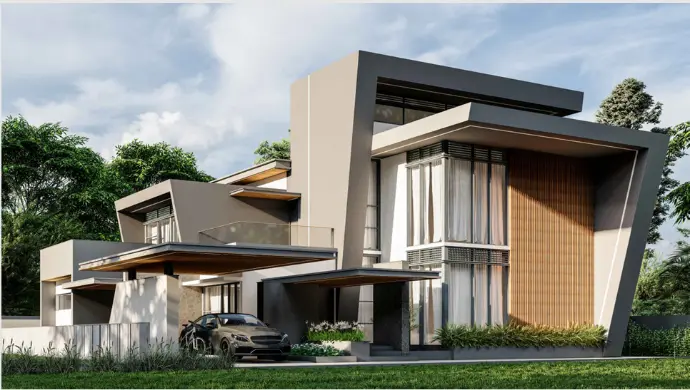Modern vs. Traditional
Architecture: What
Works Best in
Perinthalmanna?
Introduction
Perinthalmanna, a rapidly growing town in Kerala, is witnessing a transformation in its architectural landscape. As the demand for new structures rises, a debate emerges between modern and traditional architectural styles. Which approach best suits Perinthalmanna's unique environment, culture, and climate? Local architects in Perinthalmanna play a crucial role in shaping this evolving landscape, balancing innovation with heritage. This blog explores both styles, their advantages and challenges, and what works best for the town.

Understanding Modern and Traditional Architecture
Modern Architecture
Modern architecture emphasizes minimalism, open spaces, and the use of contemporary
materials like glass, steel, and concrete. It focuses on functionality, clean lines, and
innovative design techniques to create energy-efficient and technologically advanced
buildings.
Key Features:
● Minimalistic designs with open floor plans
● Use of advanced materials like reinforced concrete and glass
● Energy-efficient designs with solar panels and smart home technology
● Focus on maximizing natural light and ventilation
● Flat or low-pitched roofs
Traditional Architecture
Traditional architecture in Kerala is deeply rooted in culture, history, and local climate
conditions. It incorporates natural materials like wood, clay tiles, and laterite stone while
emphasizing sloping roofs and intricate wooden carvings.
Key Features:
● Sloping tiled roofs for effective rainwater drainage
● Usage of local materials like wood, clay, and laterite stone
● Courtyards (Nadumuttam) to enhance ventilation
● Ornamental designs reflecting Kerala’s cultural heritage
● Thick walls provide natural insulation against heat
Comparing Modern and
Traditional Architecture
in
Perinthalmanna
Climate Adaptability
● Traditional architecture is designed for Kerala’s tropical climate, providing natural
cooling and ventilation.
● Modern architecture integrates energy-efficient solutions like solar panels and insulated glass to reduce energy consumption.
Aesthetics & Cultural Significance
● Traditional buildings resonate with Kerala’s rich cultural heritage and blend seamlessly with the natural surroundings.
● Modern structures offer a contemporary appeal, suitable for urban expansion and
commercial spaces.
Cost and Maintenance
● Traditional architecture, while beautiful, can be expensive due to the use of high-quality wood and skilled craftsmanship.
● Modern architecture is often cost-effective due to prefabricated materials and minimalistic designs, reducing labor and construction time.
Sustainability & Eco-friendliness
● Traditional designs use biodegradable materials and passive cooling techniques,
making them highly sustainable.
● Modern buildings incorporate smart technology to improve energy efficiency, reducing long-term environmental impact.
What Works Best in Perinthalmanna?
The choice between modern and traditional architecture depends on the purpose of the
building and individual preferences.
● For Residential Homes: A fusion of traditional and modern architecture works best.
Homes can have the aesthetic charm of traditional design with the practicality of
modern elements like energy-efficient lighting and smart technology.
● For Commercial Buildings: Modern architecture is preferable due to its flexibility,
cost-effectiveness, and ability to accommodate high-rise structures.
● For Heritage and Cultural Spaces: Traditional architecture should be preserved to
maintain the town’s historical and cultural identity.
FAQs
Yes, many architects combine traditional features like sloping roofs and wooden interiors with modern amenities like modular kitchens and smart home systems.
Modern architecture is generally more cost-effective due to the use of readily available
materials and quicker construction methods. Traditional homes may require expensive
materials like teak wood and skilled artisans.
Both styles can be durable if constructed properly. Traditional homes are naturally resistant to Kerala’s climate, while modern buildings use advanced materials for longevity.
Modern architecture is ideal for commercial spaces due to its functional design, energy
efficiency, and adaptability to urban development.
You can incorporate sustainable features like rainwater harvesting, solar panels, insulated walls, and cross-ventilation to reduce energy consumption and promote eco-friendliness.
Conclusion
Both modern and traditional architecture have their unique benefits and challenges. In Perinthalmanna, a balanced approach that blends traditional aesthetics with modern efficiency seems to be the most practical solution. Whether you are building a home, office, or cultural space, understanding the strengths of each style will help you make an informed decision.
Build Your Dream Space with Oak Architects!
Ready to bring your vision to life? Our expert team is here to guide you every step of
the way. Whether it’s a home, office, or commercial space, we ensure a seamless
and stress-free experience.
Call Us Today: +91 9746025710